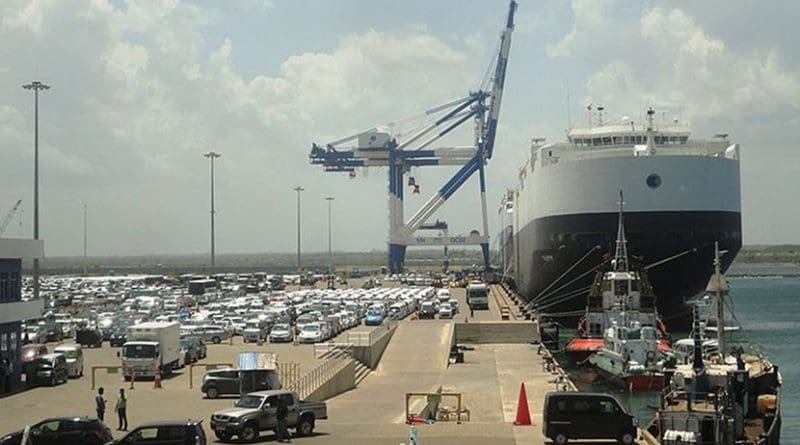Legendary Golden Sri Lanka In Economic Crisis – OpEd
By Patial RC
According to the Hindu mythology, Lord Shiva asked Vishwakarma, ‘Principle Architect of the universe’ to build a beautiful place for him and Goddess Parvati to reside after their marriage. Lord Vishwakarma designed a palace made of gold. After it was ready, a priest was invited to conduct the housewarming ritual or ‘Grih Pravesh’ of the city. The priest was none other than the learned Ravana himself! Before he became the demon king, the wise brahmin Ravana was a master scholar. When he saw Lanka, he was overwhelmed by the beauty of it. He ended up asking for the palace as his ‘Dakshina’ or reward and Lord Shiva granted his wish!
We as Indians feel saddened with the state of affairs that our southern neighbour for having been a Golden city according to the Hindu mythology has drifted to this state of an extreme economic crisis. Sri Lanka has to repay debt of about $4 billion during the rest of this year, way above its foreign currency reserves which fell to $2.31 billion by February. The Covid-19 pandemic derailed Lanka’s all-important tourism industry, even as misgovernance and overdependence on China have also contributed towards wrecking the economy.
There is a shortage of almost all necessities. Lankans voted for Rajapakshas knowing very well what they did in the past, including corruption, selling out national assets to China and indulging in dynastic politics. Rajapakshas wanted to make Sri Lanka a developed nation in a hurry. They went on an infrastructure building spree financed by Chinese loans. Rajapakshas to fulfill the election promises promptly have bankrupted the country in the process. In trying to get so many things for free, Sri Lankans actually ended up paying much higher prices. Now, Sri Lankan rupee trades for Rs 310 per dollar. Their buying power decreased. Rajapakshas in this game hve ended up destroying the country causing lot of human suffering with 15 hour powercuts, lack of food and political instability.
People love freebies and getting things cheaper. All kinds of taxes were reduced or even scrapped. A very large part of the population became tax exempt. This was very popular among the salaried class. Fuel prices were kept artificially low. They bought Petrol from India, and still sold it at prices lower than India. Populist policies ended up with No tax revenue being generated for the country.
Sri Lanka has undertaken several infrastructural projects. These include seaports, airports, roads, and other projects that are currently considered nonproductive. Different governments of Sri Lanka have taken loans from different sources at home and abroad. Instead of foreign investment, various governments have focused on borrowing.
To top it up Sri Lanka got into the Chinese Belt and Road Initiative (BRI) Infrastructure debt trap game.China’s BRI has left a large number of poor income countries burdened with heavy ‘hidden debts’ totaling $385 billion, according to new findings of a report published by AidData, based in Virginia. American statesman John Adams, who served as president from 1797 to 1801; “There are two ways to conquer and enslave a country: One is by the sword; the other is by debt.”
According to this report, China has used debt rather than aid to establish a dominant position in the international finance market. President Xi Jinping’s BRI plan, launched in 2013, has changed China’s overseas lending. BRI is part of a grand strategy to build alliances, project influence, and reshape the international balance of power in Beijing’s favour in all spheres. BRI is central to its ‘Debt-Trap Diplomacy’. China often begins as an economic partner with an economically weak country and then gradually enlarges its footprint to become its master. Sri Lanka’s Hambantota port, along with more than 6,000 hectares of land transfer to Beijing on a 99-year lease is the most glaring example of this policy.
Pakistan and Sri Lanka, have signed up for massive Chinese debt-funded infrastructure projects, are slipping into economic crisis and now are caught in political turmoil. In the Maldives too, Chinese-funded projects and loans have risen. Estimates of Chinese debts vary sharply as ‘China has a history of hiding loans’. And Chinese debt isn’t cheap; interest rates seem to be about three times what other countries charge on bilateral aid. The Americans have coined a term for the phenomenon — ‘debt-trap diplomacy’.
India has been prompt in lending a helping hand. New Delhi recently announced to extend a $1-billion line of credit, following a $400-million currency swap. An additional line of credit of $1.5 billion to import essentials is on the cards, while the Rajapaksa government is negotiating $2.5 billion in credit support from China and has sought restructuring of debt payments.
Sri Lanka is an important ally for India, considering its strategic location in the Indian Ocean Region, where China has been flexing its muscles on the military and economic fronts. Pursuing its ‘Neighbourhood First’ policy, New Delhi must go all out to rebuild the goodwill in the region. India’s assistance to help a neighbour in dire need will go a long way.
Any Foreign aid should be considered a curse. BRI Debt-Trap Diplomacy offers projects or loans on terms that end up being too difficult for countries to repay, eventually compelling them to accept political or economic concessions. China’s BRI has resulted in several such unsustainable debt-for-infrastructure deals resulting in expanding Beijing’s geostrategic interests and increasing its global presence influence through economic expansion.The existingBRI participating countries and the ones likely to be part of this white elephant initiative should exercise caution on terms and conditions before taking a plunge into the BRI. Colombo needs to pragmatically recalibrate its ties with Beijing to ensure that it doesn’t fall headlong into the Chinese BRI debt trap all over again. Sri Lanka must understand the importance of India as its immediate neighbour and always remain an all-weather friend.

